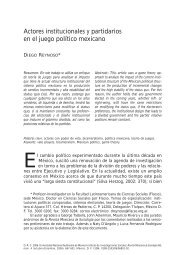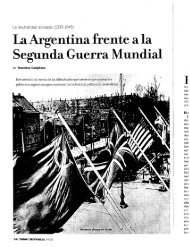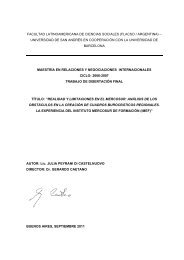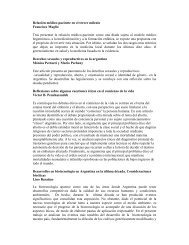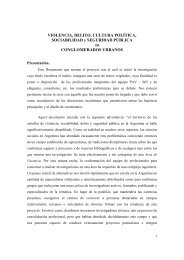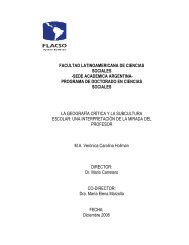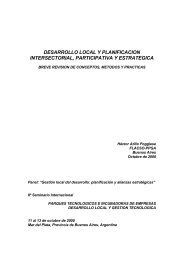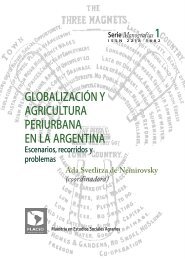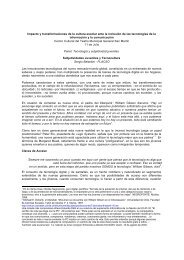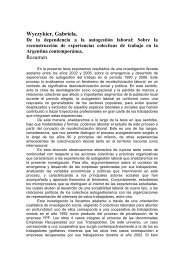Mercedes Botto Andrea Carla Bianculli - Flacso
Mercedes Botto Andrea Carla Bianculli - Flacso
Mercedes Botto Andrea Carla Bianculli - Flacso
Create successful ePaper yourself
Turn your PDF publications into a flip-book with our unique Google optimized e-Paper software.
the project on a team basis, and shared the same vision and idea regarding the integration process<br />
with Brazil24. This personal relation and connection would also be strengthened by the<br />
interministerial coordination achieved after the parliamentarian elections of 1985, which reinforced<br />
Alfonsín’s leadership. In turn, this would lead to the incorporation of an important number of<br />
officials and technical experts in the Secretary of Industry and Foreign Trade (SICE), who were<br />
deeply committed to the integration process with Brazil. This project was regarded as a possible<br />
motor of the trade liberalization scheme, or even as a means of positive adjustment. In sum, by the<br />
end of 1985, an interministerial taskforce was already in place. This relied on direct access to the<br />
highest political officials and policymakers, and its main objective was to promote the technical<br />
issues on the negotiating agenda. This taskforce was assisted and complemented by the private<br />
sector, which was acting in the shadows and was led by the so-called “captains of industry” 25.<br />
Nevertheless, this idyllic relationship would not last long and would finally come to an end in 1987,<br />
when Roberto Lavagna and his team left the SICE, and was replaced by Beatriz Nofal, after the<br />
defeat of the Radical Party in the 1987 legislative elections.<br />
Based on the suggestions and proposals presented by the different chambers and industrial sectors,<br />
Daniel Chudnovsky elaborated the final positive lists regarding national capital goods. In those<br />
cases where consensus could not be built among two or more chambers producing the same<br />
product or item, the government would directly eliminate it from the final common lists given that<br />
there were no adequate instruments to perform a technical evaluation of the competitive situation<br />
of the different products; what in turn revealed the government’s lack of capability to avoid<br />
conflictive situations [Chudnovsky, 1987].<br />
This would result in a dynamic quite different from the one proclaimed in the PICE: the promotion<br />
of intra-industry restructuring and specialization. On the contrary, the common lists that had been<br />
agreed upon at the national level would only allow for the promotion of trade in terms of the lines<br />
of production in which each country had already specialized, and did not include or affect those<br />
sub-sectors or branches of activity that showed greater reticence about this market opening26. 3.1.3. UTILIZATION IN DECISIONS<br />
24 Interview with academic.<br />
25 At the same time, though showing greater confidentiality, an informal working and advice group was<br />
created with these “captains of industry” in order to gather their political endorsement to the initiatives. Later<br />
on, this same group will form part of the mixed commission. The “captains of industry” was the name given<br />
to the economic groups that grew as state suppliers, and which, as detailed in Campbell [1999: 110], included<br />
the following business representatives: Jorge Haieck (SOCMA), Eduardo Braun (ASTARSA), Ricardo Zinn<br />
(SEVEL), Guillermo Livio Kühl (SAAB – Scania), Jaime Núñez (BAGLEY), Vittorio Orsi (SADE), Miguel<br />
Roig (Bunge y Born), Carlos Bulgheroni (BRIDAS), Carlos Tramutola (Propulsora), Alberto Hojman (BGH),<br />
and Sebastian Bagó (Laboratorios Bagó).<br />
26 In effect, as far as Argentina was concerned, the proposal focused on a certain type of machines tool<br />
industry of specific use, and in whose production costs smelting pieces impinged much more than sheet,<br />
aluminium, and metallic profiles. In the case of Brazil, on the contrary, capital goods intensive in iron and<br />
steel or of serial production predominated [Porta and Fontanals, 1989].<br />
22



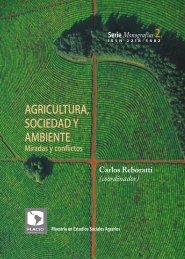
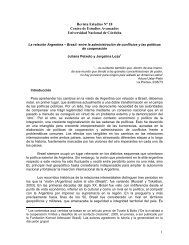
![[P] Disertacion.Melisa.Galvano.pdf - Flacso](https://img.yumpu.com/14596629/1/184x260/p-disertacionmelisagalvanopdf-flacso.jpg?quality=85)
